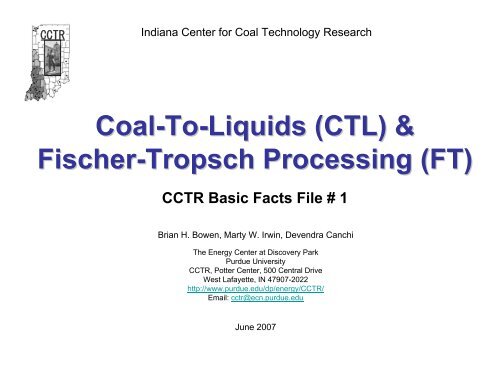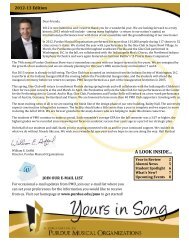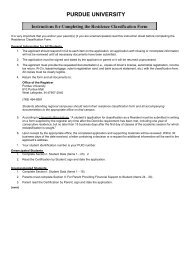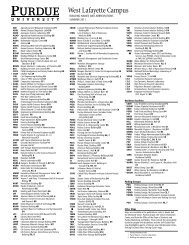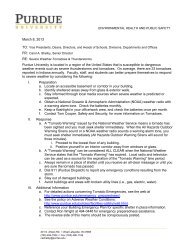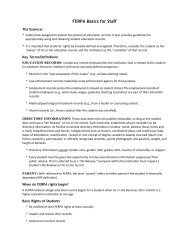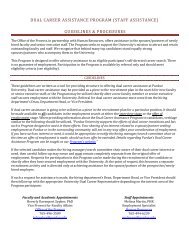Coal-To-Liquids (CTL) & Fischer-Tropsch ... - Purdue University
Coal-To-Liquids (CTL) & Fischer-Tropsch ... - Purdue University
Coal-To-Liquids (CTL) & Fischer-Tropsch ... - Purdue University
You also want an ePaper? Increase the reach of your titles
YUMPU automatically turns print PDFs into web optimized ePapers that Google loves.
CCTR<br />
Indiana Center for <strong>Coal</strong> Technology Research<br />
<strong>Coal</strong>-<strong>To</strong> <strong>Coal</strong> <strong>To</strong>-<strong>Liquids</strong> <strong>Liquids</strong> (<strong>CTL</strong>) &<br />
<strong>Fischer</strong>-<strong>Tropsch</strong> <strong>Fischer</strong> <strong>Tropsch</strong> Processing (FT)<br />
CCTR Basic Facts File # 1<br />
Brian H. Bowen, Marty W. Irwin, Devendra Canchi<br />
The Energy Center at Discovery Park<br />
<strong>Purdue</strong> <strong>University</strong><br />
CCTR, Potter Center, 500 Central Drive<br />
West Lafayette, IN 47907-2022<br />
http://www.purdue.edu/dp/energy/CCTR/<br />
Email: cctr@ecn.purdue.edu<br />
June 2007<br />
Indiana Center for <strong>Coal</strong> Technology Research<br />
1
CCTR<br />
<strong>CTL</strong> TECHNOLOGY<br />
There are two main processes:-<br />
[1] <strong>Coal</strong> to SynGas & [2] SynGas to FT Fuels<br />
With two major equipment needs:-<br />
COAL GASIFIER & FT REACTOR<br />
[1] <strong>Coal</strong> to SynGas [2]SynGas to FT Products<br />
Note: ATR, Autothermal Reformer<br />
Indiana Center for <strong>Coal</strong> Technology Research<br />
2
CCTR<br />
COAL FOR THE FT PROCESS<br />
The chemical content and physical parameters of the<br />
coal supply for gasification, prior to the FT processing,<br />
will influence the design & operation of the <strong>CTL</strong> facility<br />
Carbon forms more than 50% by weight & more than<br />
70% by volume of coal (this includes inherent moisture).<br />
This is dependent on coal rank, with higher rank coals<br />
containing less hydrogen, oxygen & nitrogen, until<br />
95% purity of carbon is achieved at Anthracite rank &<br />
above<br />
Indiana Center for <strong>Coal</strong> Technology Research<br />
3
CCTR<br />
COAL CONTENTS<br />
Volatile matter consists of aliphatic carbon atoms (linked in open<br />
chains) or aromatic hydrocarbons (one or more six-carbon rings<br />
characteristic of benzene series) and mineral matter<br />
Ash consists of inorganic matter from the earth’s crust:- limestone,<br />
iron, aluminum, clay, silica, and trace elements (concentrations of<br />
less than 1000 ppm [
CCTR<br />
TYPICAL PERCENTAGES OF CONTENT<br />
(% Weight)<br />
Moisture<br />
Fixed Carbon<br />
Ash<br />
Sulfur<br />
Bulk Density (lb/ft 3 )<br />
http://www.engineeringtoolbox.com/classification-coal-d_164.html<br />
INDIANA COAL &<br />
ILLINOIS BASIN COAL<br />
<strong>Coal</strong> Types (Rank) and Material Content<br />
Anthracite<br />
2.8 – 16.3<br />
80.5 – 85.7<br />
9.7 – 20.2<br />
0.6 – 0.77<br />
50 - 58<br />
Bituminous<br />
2.2 – 15.9<br />
44.9 – 78.2<br />
3.3 – 11.7<br />
0.7 – 4.0<br />
42 - 57<br />
Indiana Center for <strong>Coal</strong> Technology Research<br />
Lignite<br />
39.0<br />
31.4<br />
4.2<br />
0.4<br />
40 - 54<br />
5
CCTR<br />
COAL PHYSICAL PARAMETERS<br />
Each type of coal has a certain set of physical parameters<br />
which are mostly controlled by<br />
(a) carbon content<br />
(b) volatile content (aliphatic or aromatic hydrocarbons) &<br />
(c) moisture<br />
• Aliphatic - designating a group of organic chemical compounds<br />
(carbon compounds) in which the carbon atoms are linked in open chains<br />
• Aromatic - containing one or more six-carbon rings characteristic<br />
of the benzene series<br />
• Hydrocarbons - numerous organic compounds, such as benzene &<br />
methane, that contain only carbon & hydrogen<br />
Indiana Center for <strong>Coal</strong> Technology Research<br />
6
CCTR<br />
COAL RANK<br />
The degree of 'metamorphism' or coalification<br />
undergone by a coal, as it matures from peat<br />
to anthracite, has an important bearing on its<br />
physical and chemical properties, & is referred<br />
to as the 'rank' of the coal<br />
HIGH<br />
http://www.australiancoal.com.au/classification.htm#types<br />
Volatile matter, H 2 , O 2 , N<br />
Moisture Content<br />
Carbon/Energy Content<br />
Low Rank <strong>Coal</strong> High Rank <strong>Coal</strong><br />
Indiana Center for <strong>Coal</strong> Technology Research<br />
HIGH<br />
Volatile matter decreases as rank increases<br />
7
CCTR<br />
COAL VOLATILE MATTER<br />
Volatile matter is material that is driven off when<br />
coal is heated to 950°C (1,742°F) in the absence<br />
of air under specified conditions - liberated usually as<br />
a mixture of short & long chain hydrocarbons,<br />
& measured practically by determining the loss of weight<br />
Consists of a mixture of gases, low-boiling-point<br />
organic compounds that condense into oils upon<br />
cooling, & tars<br />
http://www.britannica.com/eb/article-81704/coal-utilization<br />
Indiana Center for <strong>Coal</strong> Technology Research<br />
8
CCTR<br />
SULFUR IN COAL<br />
Although coal is primarily a mixture of carbon (black)<br />
& hydrogen (red) atoms, sulfur atoms (yellow) are<br />
also trapped in coal, primarily in two forms. In one<br />
form, (1) the sulfur is a separate particle often linked<br />
with iron (green, pyritic sulfur) with no connection<br />
to the carbon atoms, as in<br />
the center of the drawing<br />
(fools gold). In the<br />
second form, (2) sulfur is<br />
chemically bound to the<br />
carbon atoms (organic<br />
sulfur), such as in the<br />
upper left<br />
Source: http:www.fossil.energy.gov/education/energylessons/coal/coal_cct2.html<br />
Indiana Center for <strong>Coal</strong> Technology Research<br />
9
CCTR<br />
GASIFICATION BASICS<br />
Indiana Center for <strong>Coal</strong> Technology Research<br />
10
CCTR<br />
PRODUCTS OF GASIFICATION<br />
Indiana Center for <strong>Coal</strong> Technology Research<br />
11
CCTR<br />
BEGINNINGS OF THE FT PROCESS<br />
The process was invented in petroleum-poor<br />
but coal-rich Germany in the 1920s, to produce<br />
liquid fuels. The invention of the original process<br />
was developed by the German researchers<br />
Franz <strong>Fischer</strong> and Hans <strong>Tropsch</strong> at the<br />
Kaiser Wilhelm Institute. It was used by<br />
Germany and Japan during World War II to<br />
produce alternative fuels. Germany's annual<br />
synthetic fuel production reached more<br />
than 124,000 barrels per day in 1944<br />
(from 25 plants, 6.5 million tons)<br />
Source: http://www.fe.doe.gov/aboutus/history/syntheticfuels_history.html<br />
Indiana Center for <strong>Coal</strong> Technology Research<br />
12
CCTR<br />
FT PROCESS BASICS<br />
The <strong>Fischer</strong>-<strong>Tropsch</strong> process uses hydrogen (H 2 )<br />
and carbon-monoxide (CO) to make different<br />
types of hydrocarbons with various H 2 :CO ratios<br />
H 2<br />
CO<br />
Hydrocarbons<br />
In a <strong>CTL</strong> facility the H 2 and CO can be<br />
supplied from the coal gasifier<br />
Indiana Center for <strong>Coal</strong> Technology Research<br />
13
CCTR<br />
FT PROCESS BASICS<br />
The original <strong>Fischer</strong>-<strong>Tropsch</strong> process is described<br />
by the following chemical equation:<br />
(2n+1)H 2 + nCO → CnH (2n+2) + nH 2 O<br />
The initial FT reactants in the above reaction (i.e. CO<br />
& H 2 ) can be produced by other reactions such as<br />
the partial combustion of a hydrocarbon or by the<br />
gasification of coal or biomass: C + H 2 O → H 2 + CO<br />
FT reactants can also be produced from methane<br />
in the gas to liquids process: CH 4 + ½O 2 → 2H 2 + CO<br />
Source: http://en.wikipedia.org/wiki/<strong>Fischer</strong>-<strong>Tropsch</strong>_process<br />
Indiana Center for <strong>Coal</strong> Technology Research<br />
14
CCTR<br />
Source: Eastman Chemical Company<br />
SYNGAS TO FT REACTOR<br />
Indiana Center for <strong>Coal</strong> Technology Research<br />
15
Proportion Converted to Hydrocarbons<br />
CCTR<br />
H2:CO :CO RATIO<br />
SynGas H 2 :CO Molar Ratio Input {(Moles of converted CO &H2)/<strong>To</strong>tal<br />
Moles of CO & H2)} to Synthesis Reactor, Fixed Volume of (CO+H 2 )<br />
The FT process still produces CO 2 although substantially<br />
smaller amounts compared with the gasification process<br />
Source: TITLE>>>>>> Williams, Larson, Jin, 2006<br />
Indiana Center for <strong>Coal</strong> Technology Research<br />
The products of FT<br />
synthesis include<br />
hydrocarbon chains,<br />
oxygenates, water<br />
& carbon-dioxide<br />
among others at<br />
varying proportions<br />
depending on the<br />
catalyst used &<br />
reactor conditions.<br />
The efficiency of<br />
the FT reaction is<br />
commonly measured<br />
by the conversion<br />
ratio, also known as<br />
the rate of FT reaction<br />
16
Height ≈ 65 ft<br />
CCTR<br />
Steam<br />
Syn-gas<br />
Diameter ≈ 15ft<br />
SLURRY- SLURRY PHASE FT REACTOR<br />
Water used for<br />
heat transfer<br />
FT Wax<br />
(Liquid Hydro<br />
carbons)<br />
SynGas bubbled<br />
into a slurry<br />
suspended with<br />
catalyst<br />
Fractions<br />
decreasing<br />
with boiling<br />
point<br />
20 o C<br />
70 o C<br />
120 o C<br />
170 o C<br />
Indiana Center for <strong>Coal</strong> Technology Research<br />
C 1 to C 4 Liquefied Petroleum Gas<br />
C 5 to C 9 Naphtha and Other Chemicals<br />
C 5 to C 10 Gasoline<br />
C 10 to C 16 Kerosene, Jet fuel<br />
C14 to C20 Diesel Oils<br />
270o C<br />
C 20 to C 50 Lubricating Oils<br />
375 o C<br />
C 20 to C 70 Fuel Oil<br />
600 o C<br />
> C 70 Residue<br />
Catalytic<br />
Hydrocracker<br />
17
CCTR<br />
‐<br />
FT & CATALYSIS<br />
The FT Process is a catalyzed chemical reaction in<br />
which carbon monoxide and hydrogen are converted<br />
into liquid hydrocarbons of various forms<br />
The catalyst used (often based on iron or cobalt) is a<br />
chemical compound that increases the rate of a<br />
chemical reaction without altering the final<br />
equilibrium (catalysis is purely a kinetic phenomenon).<br />
Catalysts reduce the free activation energy which<br />
then quickens the speed of the reaction<br />
‐<br />
+<br />
+<br />
M + C O<br />
‐<br />
+<br />
‐<br />
‐<br />
‐<br />
Indiana Center for <strong>Coal</strong> Technology Research<br />
M = Metal<br />
CO = Carbon Monoxide<br />
The ligand CO (propensity<br />
to bonding) exchanges<br />
electrons with the Metal<br />
18
CCTR<br />
CATALYSTS & PRODUCTS<br />
CATALYST PRODUCT<br />
Iron Linear alkenes and oxygenates<br />
Cobalt Alkanes<br />
Nickel Methane<br />
Ruthenium High molecular weight hydrocarbons<br />
Rhodium Large amounts of hydrocarbons & little oxygenates<br />
Note: Alkanes are hydrocarbons containing only single covalent bonds.<br />
Alkenes are hydrocarbons containing a double covalent bond between<br />
two carbon atoms. Oxygenated substances have been infused with oxygen.<br />
Oxygenates are usually employed as gasoline additives to reduce CO that<br />
is created during the burning of the fuel<br />
Indiana Center for <strong>Coal</strong> Technology Research<br />
19
CCTR<br />
<strong>CTL</strong> GLOBAL PRODUCTION RATES<br />
1944 Germany’s production = 124,000 B/D<br />
Note: B/D = Barrels per Day<br />
Source: http://www.platts.com/<strong>Coal</strong>/Resources/News%20Features/ctl/map.xml<br />
Indiana Center for <strong>Coal</strong> Technology Research<br />
20
CCTR<br />
Source: http://www.answers.com/heat%20in%20one%20barrel%20of%20oil<br />
PRODUCTS FROM A<br />
BARREL OF CRUDE OIL<br />
Indiana Center for <strong>Coal</strong> Technology Research<br />
One barrel of crude oil<br />
produces nearly half a<br />
barrel of gasoline<br />
Numbers are based on average yields<br />
for U.S. refineries in 2000. One barrel<br />
contains 42 gallons of crude oil. The<br />
total volume of products made is 2.6<br />
gallons greater than the original 42<br />
gallons of crude oil. This represents<br />
‘processing gain’<br />
21
CCTR<br />
WHAT CAN BE PRODUCED<br />
FROM A <strong>CTL</strong> FACILITY?<br />
The final products coming from a <strong>CTL</strong> facility are decided<br />
upon during the initial stages of plant design<br />
Indiana Center for <strong>Coal</strong> Technology Research<br />
22
CCTR<br />
U.S. POTENTIAL <strong>CTL</strong> REGIONS<br />
Indiana Center for <strong>Coal</strong> Technology Research<br />
23


